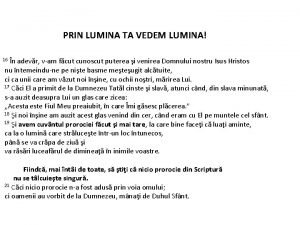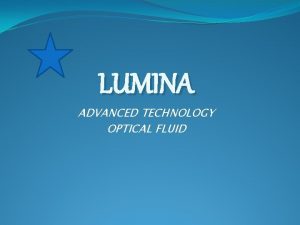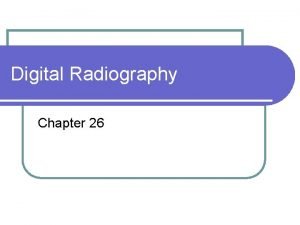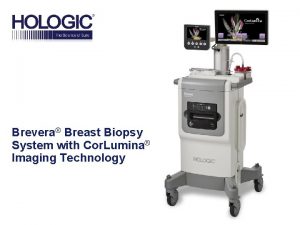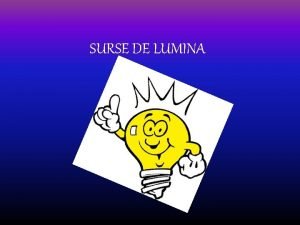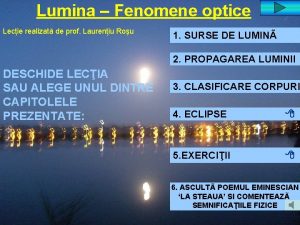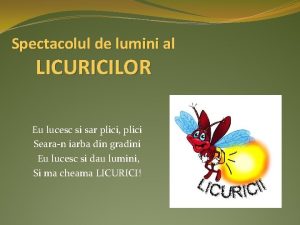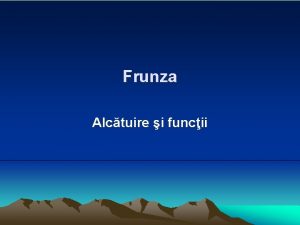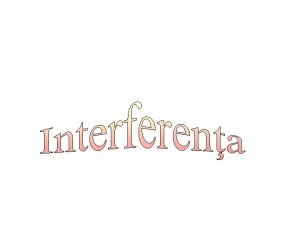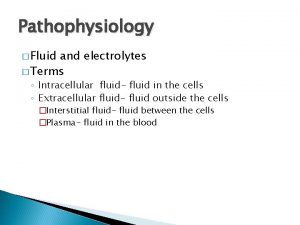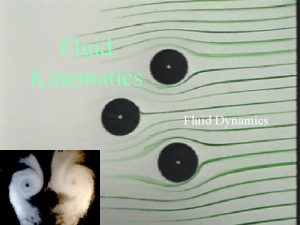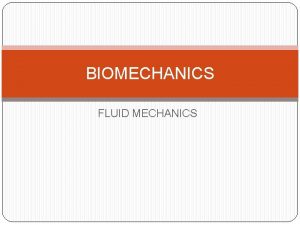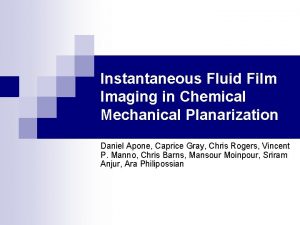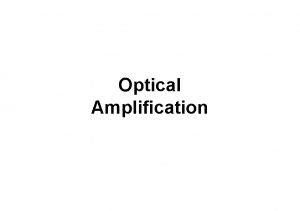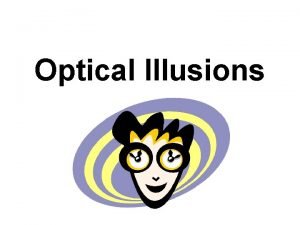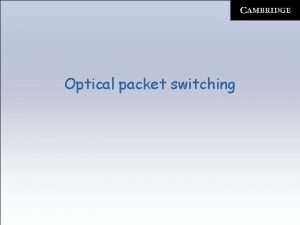LUMINA ADVANCED TECHNOLOGY OPTICAL FLUID IMAGING FROM FILM

























- Slides: 25

LUMINA ADVANCED TECHNOLOGY OPTICAL FLUID

IMAGING FROM FILM �The Naked Eye: Personal View �Reproductive Imaging �Wet Darkroom �Digital Scan All Three Imaging methods: �Are subject to and limited by optic’s laws �Are subject to the imaging method’s capabilities and limitation

REPRODUCTIVE IMAGING �Wet Darkroom �Transfers data from one medium to another �Laborious process �Low reproducibility even by same operator �Output media dependent �Good to poor fidelity to the original �Second generation duplicates unlike original

Reproductive Imaging Methods Compared Wet Darkroom � Transfers data from one decaying medium to another decaying medium � Laborious process � Difficult and laborious repetitive iteration or editing � Original always needed � Low fidelity of Second generation duplicates Digital Scan � Preserves data from one decaying medium to nondecaying numbers. � Relatively Simple process � Easy repetitive iteration or editing. � Original needed the first time only. � Identical second generation duplicates

Optical Limitations of DRY Imaging from Film �Light going through dry film is subject to some Scattering at the film grain. Consequences: � Lower contrast � Emphasized grain � Reduction in color saturation � Over emphasis on scratches and dust � Reduced dynamic range �Limitations shared by analog and digital methods but can be overcome for both.

DRY Imaging from Film PHYSICAL limitations �Film Curvature �Correction requires glass: negative consequences: �Additional refraction, -Loss of sharpness and contrast �Use of Anti Newton Glass: Loss of sharpness and contrast.

Optical Advantages of FLUID Imaging from Film �Elimination of air / film interphase �Elimination of Light scattering at grain = � Higher contrast � Greater sharpness � Higher fidelity rendition of grain � Higher color saturation � Dust and scratch-reduction or elimination � Rich gradation

PHYSICAL Advantages of FLUID Imaging from Film �Film Flatness = Uniform plane of focus �Glass needed only on one side �Glass can be placed in non-refractive position �On side of light relative to film’s emulsion �Avoids Anti Newton Glass

The Ideal Imaging Fluid �Causes no physical damage to Film or equipment � Not a solvent: Does not dissolve film backing or emulsion or drums, if drum scanned. �Chemically inert under use or storage conditions � Try the Scan. Science Cup Test. �Odourless �Operator Safe: � Low Vapour toxicity: � Free of Carcinogens, or target-organ toxics, � Free of aromatic Hydrocarbons, Olefins and n-Hexane � Not flammable under normal use conditions � High Flash Point �Non toxic ? � No such thing, all hydrocarbons are toxic by ingestion

Imaging Fluids: Special Concerns with Legacy Film �Many Film variants �Nitrocellulose > Other cellulose backed films containing aromatic plasticizer: Tri-Phenyl Phosphate (TPP) �Fluids containing aromatic hydrocarbons can extract the TPP : cause dimensional changes to film, increase brittleness Try Scan. Science Cup Test: tests solvent aggressiveness of fluid against Polystyrene a polyaromatic polymer. � Fluids that damage polystyrene can also extract TPP and may damage scanner drums �

IMAGING FLUIDS EVOLUTION �Developers of the Drum Scanner run Into Newton, Rings, they knew those could be eliminated by fluid mounting. �These guys tried baby oil, and it worked. �The first generation imaging fluid was born!

Results were great. . . �But the drudgery had begun. �As It turned out, baby's bottoms were better with oil, not drums. �Cleaning the drum required nasty, volatile and smelly stuff. �If it were possible to eliminate the cleaning that would be great! �There had to be a better way. A Better way?

A better way? Really? �Why not use the smelly volatile stuff used for cleaning the scanning oil as the scanning fluid. . . �Voila, it evaporated after use no cleaning needed! �The Second Generation imaging fluid was born! �The cleaner, now the scanning fluid: the smell was the same, bad. �Ah! but a great time saver. That was real progress. �With the second generation scanning fluids Baby Oil went back to being baby oil and �The cleaning drudgery was gone.

All That Happened In. . THE LAST CENTURY �Not bad for empirical DIY.

Primary on Newton �Light that strikes two reflective surfaces in close proximity and a slight angle to each other yields two wave fronts which reinforce each other when in phase or destruct when out of phase. �The result is a series of lighter or darker rings. �If the reflective surfaces are kept parallel, the resulting wave fronts are both in phase: therefore, No Newton rings! �But, glass, if used to flatten film is a refractive element that degrades the image. A trade off.

Avoiding Newton Rings A better way �Filling the air space between the two reflective surfaces with a fluid: � Forces the film into a flat plane � Eliminates the air space between reflective surfaces, makes the surfaces parallel and banishes Newton Rings. �Without fluid scanning, drum scanners could have not become a commercial reality. �The same technology is available to all scanners

Oil-type Imaging Fluids Pros �THE PRO’S �Scanning Oils are practically Chemically inert to film and scanner drums. �The Oils high molecular contributes to their low volatility and solvency. �Oils have no tendency to flash off at the edges of the fluid mount.

Oil-type Imaging Fluids �PRO’S CONTINUED �Scanning Oils are stable in storage because they are devoid of the reactive and smelly components natural to less pure petroleum hydrocarbons �The Oils low volatility means no vapours released �Oils are essentially not flammable. Big plus! �The Oils high viscosity and low volatility help maintain a good temporary bond between the components of the fluid mount. No flash off.

First Generation Scanning Fluids �THE PROS, . . . CONTINUED �That was the good news!

Oil-type Imaging Fluids CONS �Like bad guests, they won't go away when the party is over and need to be forcefully expelled. �Removing the oil requires dry wiping / dilution with other hydrocarbon solvents which are volatile, and potentially flammable. �Cleaning solvents solvent power must be high enough to remove tape residues. The added solvency can be incompatible with the drum or the coatings of some scanner glass beds.

Scanning fluids The Second Generation �Main advantages: no clean up required. �Self cleaning, evaporate quickly after the scan. �Main disadvantage: �High volatility = vapour build up, �Highly flammable below the freezing point. �Gasoline-like smell, �Substances present: those normally contained in less refined, cheaper, petroleum distillates. � Aromatic and olefinic hydrocarbons

NEW TECHNOLOGY LUMINA Third Generation THE CONVERGENCE OF CHEMISTRY AND PHYSICS

LUMINA The Ideal Imaging Fluid �A 'Lens'. -not a solvent: will not damage film or equipment. �Lumina is an inert optical medium �Earth and Operator friendly: Good for your image and you. �High purity and consistent quality �Odorless �Doesn't' t flash-off while scanning �Dries clean, leaves no residues �NOT flammable at Room Temperature �Low vapour toxicity �Similar Refractive index as film

The Scan. Science Cup Test Polystyrene foam is highly susceptible to attack by solvents, particularly those containing aromatic and cyclic hydrocarbons. As a rule, these substances have greater solvency. The cup at the center is a new cup. The cup at the left contained LUMINA for 24 hours. The cup at the right contained a second generation scanner fluid during 24 hours. Try the test yourself before trusting your film or scanner to an imaging fluid.

LUMINA Breathing life on your Images See us at www. scanscience. com
 Vam v-am
Vam v-am Lumina scanning fluid
Lumina scanning fluid Frc control system
Frc control system Optical imaging
Optical imaging Is2000 the advanced imaging solution
Is2000 the advanced imaging solution Chapter 39 digital imaging film and radiographs
Chapter 39 digital imaging film and radiographs Chapter 39 digital imaging film and radiographs
Chapter 39 digital imaging film and radiographs Brevera biopsy system
Brevera biopsy system Optical density film
Optical density film Is synovial fluid extracellular fluid
Is synovial fluid extracellular fluid Fluid statics deals with fluid at rest
Fluid statics deals with fluid at rest Fluid statics deals with
Fluid statics deals with Intracellular fluid and extracellular fluid examples
Intracellular fluid and extracellular fluid examples Solute definition
Solute definition Hypoosmotic
Hypoosmotic Boundary layer theory
Boundary layer theory Extracellular fluid and interstitial fluid
Extracellular fluid and interstitial fluid Shifting dullness
Shifting dullness Marine fluid systems
Marine fluid systems Curcubeul referat
Curcubeul referat Propagarea luminii
Propagarea luminii Isus luceste ca un soare
Isus luceste ca un soare Larva licurici
Larva licurici Orienteaza limbul frunzei catre lumina
Orienteaza limbul frunzei catre lumina What is laminar and turbulent flow
What is laminar and turbulent flow Aplicatii ale fenomenului de reflexie totala
Aplicatii ale fenomenului de reflexie totala
